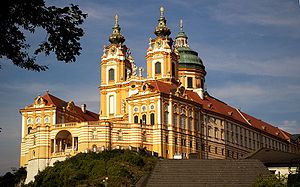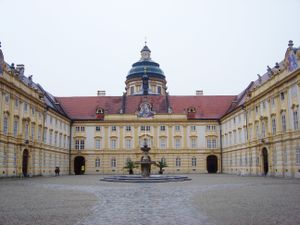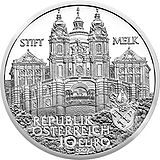
Melk Abbey
Encyclopedia


Austria
Austria , officially the Republic of Austria , is a landlocked country of roughly 8.4 million people in Central Europe. It is bordered by the Czech Republic and Germany to the north, Slovakia and Hungary to the east, Slovenia and Italy to the south, and Switzerland and Liechtenstein to the...
n Benedictine abbey
Abbey
An abbey is a Catholic monastery or convent, under the authority of an Abbot or an Abbess, who serves as the spiritual father or mother of the community.The term can also refer to an establishment which has long ceased to function as an abbey,...
, and one of the world's most famous monastic
Christian monasticism
Christian monasticism is a practice which began to develop early in the history of the Christian Church, modeled upon scriptural examples and ideals, including those in the Old Testament, but not mandated as an institution in the scriptures. It has come to be regulated by religious rules Christian...
sites. It is located above the town of Melk
Melk
Melk is a city of Austria, in the federal state of Lower Austria, next to the Wachau valley along the Danube. Melk has a population of 5,222 ....
on a rocky outcrop overlooking the river Danube
Danube
The Danube is a river in the Central Europe and the Europe's second longest river after the Volga. It is classified as an international waterway....
in Lower Austria
Lower Austria
Lower Austria is the northeasternmost state of the nine states in Austria. The capital of Lower Austria since 1986 is Sankt Pölten, the most recently designated capital town in Austria. The capital of Lower Austria had formerly been Vienna, even though Vienna is not officially part of Lower Austria...
, adjoining the Wachau
Wachau
The Wachau is an Austrian valley with a picturesque landscape formed by the Danube river. It is one of the most prominent tourist destinations of Lower Austria, located midway between the towns of Melk and Krems that also attracts "connoisseurs and epicureans". It is in length and was already...
valley.
The abbey was founded in 1089 when Leopold II, Margrave of Austria
Leopold II, Margrave of Austria
Leopold II was a Babenberg Margrave of Austria ruling from 1075 onwards. He was known as Leopold the 'fair'. He was the son of Ernest the Brave and Adelheid, the daughter of Margrave Dedi II of Meissen...
gave one of his castles to Benedictine monks from Lambach Abbey
Lambach Abbey
Lambach Abbey is a Benedictine monastery in Lambach in Austria.-History:A monastery was founded in about 1040 by Bishop Adalbero of Würzburg , which since 1056 has been a Benedictine abbey. During the 17th and 18th centuries a great deal of work in the Baroque style was carried out, much of it by...
. A monastic school, the Stiftsgymnasium Melk
Stiftsgymnasium Melk
Stiftsgymnasium Melk is an Austrian Benedictine-run gymnasium in the Lower Austria city of Melk. The Roman Catholic school is set in the well-known monastery Melk Abbey...
, was founded in the 12th century, and the monastic library soon became renowned for its extensive manuscript collection. The monastery's scriptorium
Scriptorium
Scriptorium, literally "a place for writing", is commonly used to refer to a room in medieval European monasteries devoted to the copying of manuscripts by monastic scribes...
was also a major site for the production of manuscripts. In the 15th century the abbey became the centre of the Melk Reform movement which reinvigorated the monastic life of Austria and Southern Germany.
Today's impressive Baroque
Baroque
The Baroque is a period and the style that used exaggerated motion and clear, easily interpreted detail to produce drama, tension, exuberance, and grandeur in sculpture, painting, literature, dance, and music...
abbey was built between 1702 and 1736 to designs by Jakob Prandtauer
Jakob Prandtauer
Jakob Prandtauer was an Austrian Baroque architect....
. Particularly noteworthy is the abbey church with fresco
Fresco
Fresco is any of several related mural painting types, executed on plaster on walls or ceilings. The word fresco comes from the Greek word affresca which derives from the Latin word for "fresh". Frescoes first developed in the ancient world and continued to be popular through the Renaissance...
s by Johann Michael Rottmayr
Johann Michael Rottmayr
Johann Michael Rottmayr , was an Austrian painter. He was the first notable baroque painter north of Italy....
and the impressive library
Library
In a traditional sense, a library is a large collection of books, and can refer to the place in which the collection is housed. Today, the term can refer to any collection, including digital sources, resources, and services...
with countless medieval manuscripts, including a famed collection of musical manuscripts and fresco
Fresco
Fresco is any of several related mural painting types, executed on plaster on walls or ceilings. The word fresco comes from the Greek word affresca which derives from the Latin word for "fresh". Frescoes first developed in the ancient world and continued to be popular through the Renaissance...
s by Paul Troger
Paul Troger
Paul Troger was an Austrian painter, draughtsman and printmaker of the late Baroque period. Troger's illusionistic ceiling paintings in fresco are notable for their dramatic vitality of movement and their palette of light colors.Paul Troger’s style, particularly in his frescoes, dominated Austrian...
.
Due to its fame and academic stature, Melk managed to escape dissolution under Emperor Joseph II
Joseph II, Holy Roman Emperor
Joseph II was Holy Roman Emperor from 1765 to 1790 and ruler of the Habsburg lands from 1780 to 1790. He was the eldest son of Empress Maria Theresa and her husband, Francis I...
when many other Austrian abbeys were seized and dissolved between 1780 and 1790. The abbey managed to survive other threats to its existence during the Napoleonic Wars
Napoleonic Wars
The Napoleonic Wars were a series of wars declared against Napoleon's French Empire by opposing coalitions that ran from 1803 to 1815. As a continuation of the wars sparked by the French Revolution of 1789, they revolutionised European armies and played out on an unprecedented scale, mainly due to...
, and also in the period following the Nazi Anschluss
Anschluss
The Anschluss , also known as the ', was the occupation and annexation of Austria into Nazi Germany in 1938....
that took control of Austria in 1938, when the school and a large part of the abbey were confiscated by the state.
The school was returned to the abbey after the Second World War and now caters for nearly 900 pupils of both sexes.
Since 1625 the abbey has been a member of the Austrian Congregation
Austrian Congregation
The Austrian Congregation is a congregation of Benedictine monasteries situated in Austria, within the Benedictine Confederation.-History:The Congregation was founded on 3 August 1625 by Pope Urban VIII, and consisted of eleven Benedictine monasteries in Austria:*Altenburg Abbey*Garsten...
, now within the Benedictine Confederation
Benedictine Confederation
The Benedictine Confederation of the Order of Saint Benedict is the international governing body of the Order of Saint Benedict.-Origin:...
.
In his well-known novel The Name of the Rose
The Name of the Rose
The Name of the Rose is the first novel by Italian author Umberto Eco. It is a historical murder mystery set in an Italian monastery in the year 1327, an intellectual mystery combining semiotics in fiction, biblical analysis, medieval studies and literary theory...
, Umberto Eco
Umberto Eco
Umberto Eco Knight Grand Cross is an Italian semiotician, essayist, philosopher, literary critic, and novelist, best known for his novel The Name of the Rose , an intellectual mystery combining semiotics in fiction, biblical analysis, medieval studies and literary theory...
named one of the protagonists "Adson von Melk" as a tribute to the abbey and its famous library.
Photos

See also
- Melk Abbey was recently selected as the main motif of a very high value collectors' coin: the Austrian Melk Abbey commemorative coin, minted on April 18, 2007. The obverse shows a view up to the façade of the abbey church and its two side wings from a low level. The twin baroque towers and the great dome of the church behind them can be seen. In the lower right corner the coat-of-arms of the Abbey of Melk (the crossed keys of St. Peter) can be seen.

